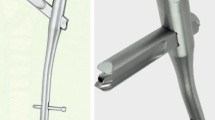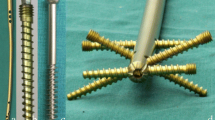Abstract
Introduction: The theoretical advantages of intramedullary fixation for peritrochanteric fractures were lessened in practice by implant-related operative problems and postoperative complication. Materials and methods: Forty-nine patients were treated with a newly designed expandable proximal femoral nail (EPFN) and followed thereafter for a minimum of 6 months. Results: After experience was gained in carrying out the procedure, its mean duration was limited to 43.4±20.2 min and total mean fluoroscopy time to 39.8±16.1 s. Due to minimal extent of soft tissue trauma blood loss was negligible and rate of postoperative infections reduced. Condensation of cancellous bone in the femoral head as an alternative to reaming and the blunt cone-shaped head of the peg reduced the frequency of head peg cut-out. Homogenic load distribution along the nail interface decreased the concentration of stress and thereby eliminated the risk of postoperative femoral fracture distal to the implant stem. Conclusion: The EPFN may be considered as a further evolution of implants designed to stabilize peritrochanteric fractures of all grades.



Similar content being viewed by others
Notes
Disc-O-Tech Medical Technologies Ltd, Israel
References
Ahrengart L, Tornkvist H, Fornander P (2002) A randomized study of the compression hip screw and gamma nail in 426 fractures. Clin Orthop 401:209–222
Bannister GC, Gibson AG, Ackroyd CD et al (1990) The fixation and prognosis of trochanteric fractures. A randomized prospective controlled trial. Clin Orthop 254:242–246
Baumgaertner MR, Curtin SL, Lindskog DM (1995) The value of the tip-apex distance in predicting failure of peritrochanteric fracture fixation. J Bone Joint Surg Am 77:1058–1064
Baumgaertner MR, Curtin SL, Lindskog DM (1998) Intramedullary versus extramedullary fixation for the treatment of intertrochanteric fractures. Clin Orthop 348:87–94
Bridle SH, Patel AD, Bircher M et al (1991) Fixation of intertrochanteric fractures of the femur. A randomized prospective comparison of the gamma nail and the dynamic hip screw. J Bone Joint Surg Br 73:330–334
Clawson DK (1964) Trochanteric fractures treated by the sliding screw plate fixation method. J Trauma 27:737–752
Davis J, Harris MB, Duval M et al (1991) Pertrochanteric fractures treated with the Gamma nail: technique and report of early results. Orthopedics 14:939–942
Halder SC (1992) The Gamma nail for peritrochanteric fractures. J Bone Joint Surg Br 74:340–344
Hardy DCR, Descamps P-Y, Krallis P et al (1998) Use of intramedullary hip-screw compared with compression hip-screw with a plate for intertrochanteric femoral fractures. J Bone Joint Surg Am 80:618–630
Hoffman CW, Lynskey TG (1996) Intertrochanteric fractures of the femurs: a randomized prospective comparison of the Gamma nail and the Ambi hip screw. Aust NZ J Surg 66:151–155
Jensen JS (1980) Mechanical strength of Jewett and McLaughlin hip nail plates manufactured from cobalt–chromium–molybdenum alloy. A biomechanical study of unstable trochanteric fractures. IV. Acta Orthop Scand 51(1):145–156
Jewett EL (1941) One-piece angle nail plate for trochanteric fractures. J Bone Joint Surg 23:803–810
Keats AS (1978) ASA classification of physical status—a recapitulation. Anesthesiology 49:233–236
Kukla C, Heinz T, Gaebler C et al (2001) The standard Gamma nail: critical analysis of 1,000 cases. J Trauma 51:77–83
Leung KS, So WS, Shen WY et al (1992) Gamma nails and dynamic hip screws for peritrochanteric fractures. A randomized prospective study in elderly patients. J Bone Joint Surg Br 74:345–351
Lindsley RW, Teal P, Probe RA et al (1991) Early experience with the Gamma interlocking nail for pertrochanteric fractures of the proximal femur. J Trauma 31:1649–1668
McKibbin B (1978) The biology of fracture healing in long bones. J Bone Joint Surg Br 60:150–162
Medoff RJ, Maes K (1991) A new device for the fixation of unstable pertrochanteric fractures of the hip. J Bone Joint Surg 73:1192–1199
Mahomed N, Harrington I, Kellam J et al (1994) Biomechanical analysis of the Gamma nail and sliding hip screw. Clin Orthop 304:280–288
Muller ME, Allgower M, Schneider R et al (1991) Manual of internal fixation, 3rd edn. Springer, Berlin Heidelberg New York, pp 140–141
Osnes EK, Lofthus CM, Falch JA et al (2001) More postoperative femoral fractures with the Gamma nail than the sliding screw plate in the treatment of trochanteric fractures. Acta Orthop Scand 72:252–256
Radford PJ, Needoff M, Webb JK (1993) A prospective randomized comparison of the dynamic hip screw and the Gamma locking nail. J Bone Joint Surg Br 75:789–793
Rhinelander FW (1968) The normal microcirculation of diaphyseal cortex and its response to fracture. J Bone Joint Surg Am 50:784–800
Rosenblum SF, Zuckerman JD, Kummer FJ et al (1992) A biomechanical evaluation of the Gamma nail. J Bone Joint Surg Br 74:352–357
Schatzker J, Waddell JP (1980) Subtrochanteric fractures of the femur. Orthop Clin North Am 11:539–554
Schipper JB, Steyerberg EW, Castelein RM et al (2004) Treatment of unstable trochanteric fractures. Randomized comparison of the Gamma nail and the proximal femoral nail. J Bone Joint Surg Br 86:86–93
Author information
Authors and Affiliations
Corresponding author
Additional information
An erratum to this article can be found at http://dx.doi.org/10.1007/s00402-006-0208-4
Rights and permissions
About this article
Cite this article
Folman, Y., Ron, N., Shabat, S. et al. Peritrochanteric fractures treated with the Fixion expandable proximal femoral nail: technical note and report of early results. Arch Orthop Trauma Surg 126, 211–214 (2006). https://doi.org/10.1007/s00402-006-0110-0
Received:
Published:
Issue Date:
DOI: https://doi.org/10.1007/s00402-006-0110-0




